Glacial kamping and gastric kaos: Karakoram to Kashgar
Hmmmm, so what have we been up to? Seems a lot has happened since i last posted. Have to cast my mind back to Gilgit, only several weeks and >1000 kms ago, yet it seems like an age. Time plays strange tricks like that,........Impermanence and constant change our friends for infinity,.....
We left Gilgit by mini-bus, revved up and well rested after the Naltar valley trek. Managed to get a few photos from that trek uploaded here and have included them below.
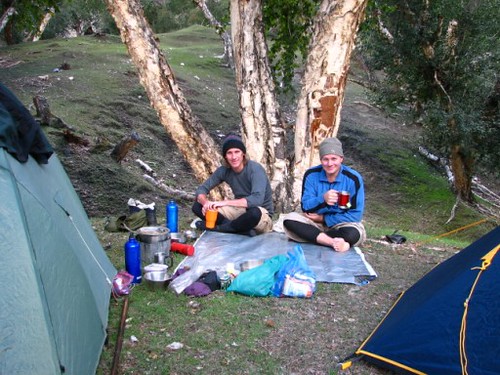 Mark and Joe at the end of first days trekking in Naltar - glad to rest those feet!
Mark and Joe at the end of first days trekking in Naltar - glad to rest those feet!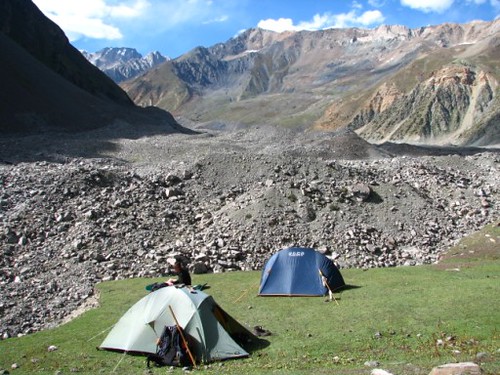 High camp on the Naltar trek, Shani or "Pure place where fairies abide"
High camp on the Naltar trek, Shani or "Pure place where fairies abide"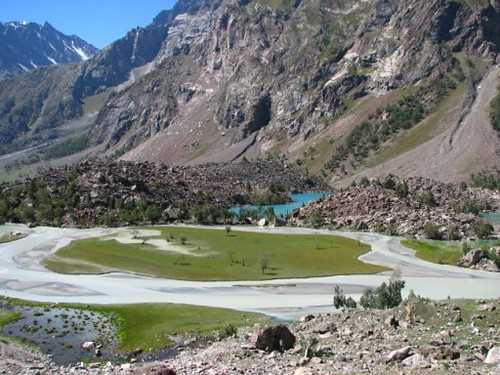 Blues and greens of Naltar glacial lake and braided streams
Blues and greens of Naltar glacial lake and braided streams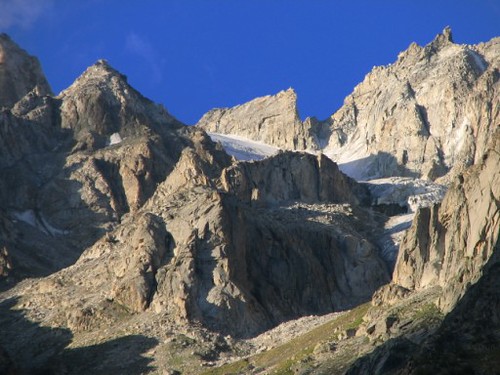 Jagged peaks fringing the Naltar valley
Jagged peaks fringing the Naltar valley
Wild gorges with impossibly steep sides closed in as the Hunza valley began to narrow and the road clung - just - to the edge of crumbling cliffs, grey water thrashing far below. The bus dodging fresh rockfalls splattered across the tar. An enduring image for me was the sight of a roadside chicken vendor in a grubby little roadside village, reclining in a wicker chair, arms folded behind his head, an indecipherable look in his young brown eyes. Before him a dark wooden table; a bloody, feathered-knife; and a set of scales. Scuttling around his feet, dozens of fat, white chickens, missing tail feathers as a result of their cramped nightly confinement and mutual butt-pecking. How many practices had it taken to get so quick (??~2 mins) to grab, chop, slit, pull, skin, weigh and plastic-bag, a now dead chicken for a waiting customer. Life and death of a chook on the Hunza roadside.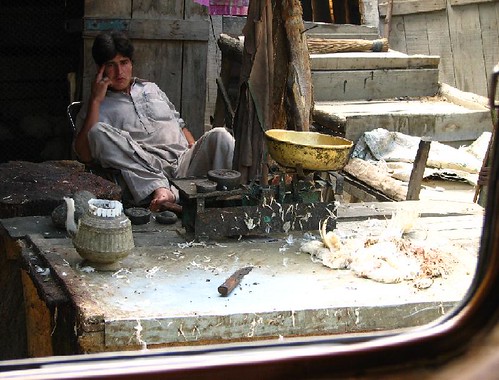 Why did the chicken cross the road?? To get away from the roadside chicken wallah,...
Why did the chicken cross the road?? To get away from the roadside chicken wallah,...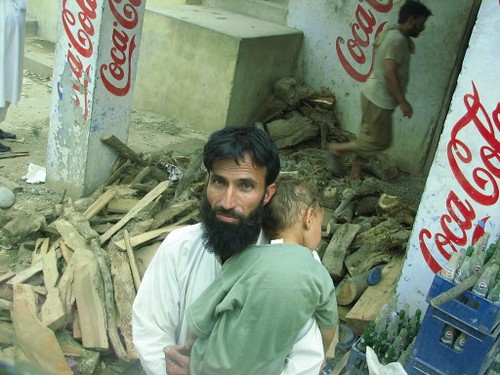 Pakistani man with young child at a roadside truckstop
Pakistani man with young child at a roadside truckstop
We arrived at beautiful Minapin, in the shady compound of a quiet guesthouse, lush with colourful flowers and apple trees bursting with ripe fruit, nestled in the footslopes of the towering Rakaposhi - a 7800 m Karakoram giant that looms over the Hunza valley.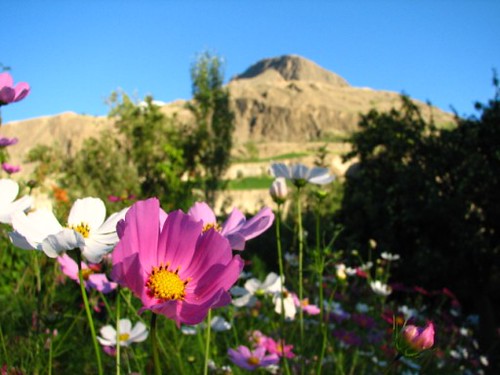 Beautiful gardens full of light at Minapin
Beautiful gardens full of light at Minapin
We were planning a short two day trek up to the edge of the Rakaposhi glacier, but some un-cooperative bacteria had other plans. For the next 24 hrs i ended up with the most violent case of watery gush i've yet experienced travelling - western medications did nothing at all - and the flow was finally stopped by force eating a large plate of plain cooked rice. Errrgh. It seriously took the stuffing out of me and at least a good week afterwards before i began to feel anything like normal energy levels returning. I guess it was a nice place to get sick!! Mark was hit by something similar the day after, but a bit less severe. Even Joe has had a intermittent case of dodgy guts! Impossible to know what it was - water or food (?) - the bugs were on our trail and zeroing in, but i think we managed to throw the scent with a 7 day trek along the Batura glacier in the Upper Hunza (more about that later).
I write about it kind of lightly, but it was an intense experience actually. The first time in adult life where i have deeply felt the frailty of this body and the ease of which life can slip away from it. It has left me with an uneasy sense of death, which is uncomfortable, but at the same time a wholesome thing if faced with some consiousness.
We met a lovely Swiss couple in Minapin who were travelling overland from Europe in an exceedingly well decked out 4WD van (see below). They gave us a lift to Karimabad, the 'capital' of the Hunza Valley, where we spent a couple of days recovering and checking out the small town and orchard covered slopes. An intended day walk to the Ultar meadow above the town was blocked by a large landslip, so we had to be content with laying low. Walking blocked again.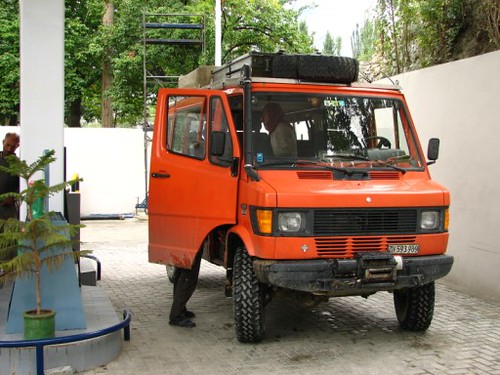 Travelling in Swiss style!
Travelling in Swiss style!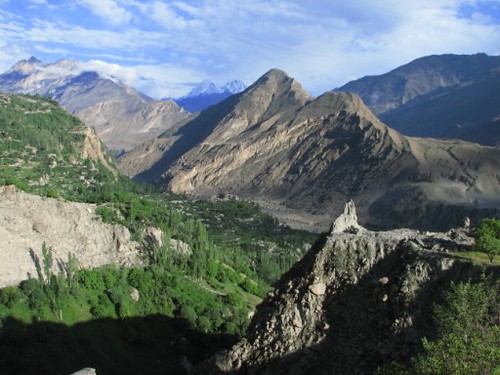 Views from Karimabad of the orchard studded Hunza Valley
Views from Karimabad of the orchard studded Hunza Valley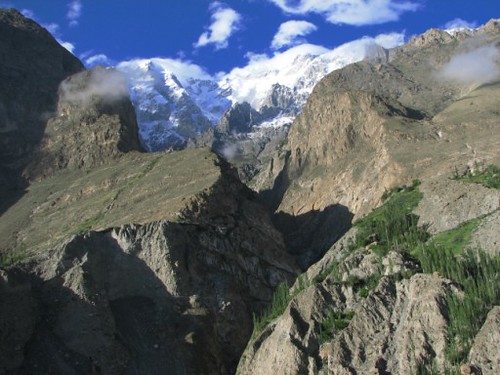 Ultar meadow valley where the trail was blocked by a recent slide
Ultar meadow valley where the trail was blocked by a recent slide
There is a large, mud and stone fort perched strategically above the town with commanding views of the valley. This was Mir of Hunza's pad before the British ousted him into exile in the 1890's after he made one threat too many - something about putting the head of any British officer who stepped into his Kingdom on a platter i think.
Many a Great Game power play and strategic chicanery was acted out in this region and it is easy to imagine stepping back into the history of not-so-long ago. Francis Younghusband (a most intruiging character, better known for the military expedition he led to Lhasa in 1904), was sent here by the Brits to 'tame' the Mir of Hunza who was mounting raids on trading caravans running between Leh and Yarkand. He only had an escort of 6 Ghurkas and was lucky to get away with his life, mostly through bluff and self-inflated Imperial gusto. He (Francis) decided that the Mir was a pretty rough-nut and was only likely to be impressed by a display of 'raw military might', so he organised the Ghurkas to do a drill and then fire a volley at a rock across the valley. The Mir was suitably impressed and then pointed out a man walking along a water channel some distance away and asked Younghusband to order the Gurkhas to shoot him. Younghusband resisted saying that the Ghurkas were so accurate they would surely hit him. The confused Mir replied "What does it matter, he belongs to me?". Very different notions of life and death, value and meaning. Kind of glad to be passing through here 100 yrs later.
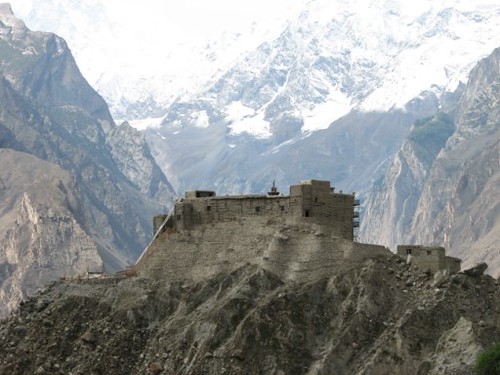 Baltit fort in Karimabad, once home to the 'friendly' Mir of Hunza
Baltit fort in Karimabad, once home to the 'friendly' Mir of Hunza
Water is life here. Water is life everywhere; but it is outstandingly obvious here. The dry rocky slopes of the Hunza receive neglible rain and massive solar radiation - so in its natural state, this is semi-desert landscape. It is lush and bountiful only because of hundreds of years of incredibly skillful channelling of glacial meltwaters along slopes and down onto flattened areas. Without this use of water the Hunza would be mostly devoid of human settlements; barren, dusty and grim.
Observing the state of this Earths waters and the way we humans treat them is a substantial part of this journey for me. We humans so easily foget our sacred duty as intelligent caretakers and the depth of our connection and interdependence on clean water, readily acting as if we are seperate. We are not.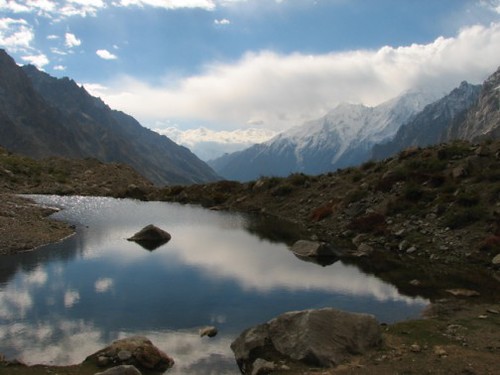 High Lake in upper Batura
High Lake in upper Batura
An image of a mistreated and overburdened river in Rawalpindi-Islamabad is burned deep into my retina; A large channel near the Afghan refugee camp, with the steep banks typical of a monsoonal river, flowing with black, anoxic soup, overloaded with human refuse and belching sulphurous fumes. There were many grey, leafless trees along the side of the banks. The branches of the trees were littered with flood debris marking previous monsoon high water levels - however the flood debris consisted solely of white, pink, blue and yellow plastic bags - fluttering in the breeze like surreal leaf-subsitutes. Not so great at photosynthesis i'd be guessing. Where the rivers are poisioned, so to are the people. Where the rivers die,.....
I can't help but think of the bacteria that were chasing us; the millions of people who experience such dead and contaminated 'water' as their daily reality and the chonic dystentry they must live with. Salt-water drops of sadness well up in me at our ignorance,......
However, we left Karimabad with a plan! - to do a week long trek along the Batura glacier in the upper Hunza! We hired a jeep to take us to Passu, the roadside starting point for the trek. This was a wonderful move as it allowed us to lift the canvas cover and tell the driver to go slow - thus we were all stunned by one of the most amazing jeep rides we are ever likely to take, along the flanks of the towering Hunza river gorge. Astounding stuff.
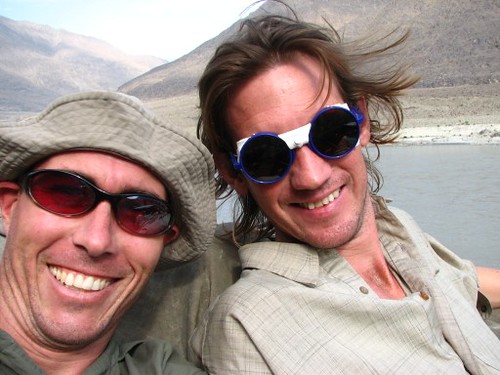 Joe and Scott goofing on the roof of a bus along the Indus
Joe and Scott goofing on the roof of a bus along the Indus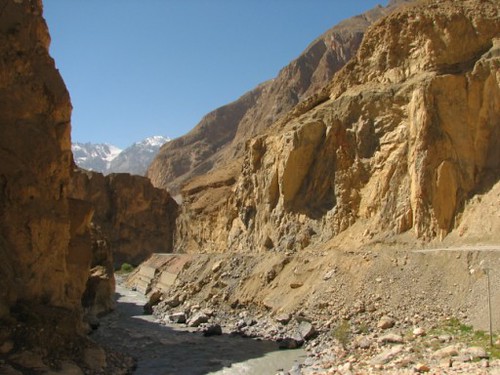 Narrow gorge along the upper Hunza valley
Narrow gorge along the upper Hunza valley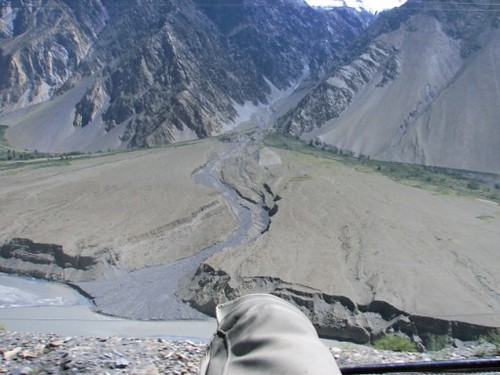 A massive alluvial fan seen from the Jeep on the way to Passu
A massive alluvial fan seen from the Jeep on the way to PassuPassu itself was located in an amazing setting (i keep using the same adjectives, but what to do??), a crazy backdrop of organpipe spires, stacked on one another, launching for the sky. Mark lined up a local porter for us, an older fella called Habib. He was really relaxed and this turned out to be a great decision as he carried our food and tents allowing us to reduce our individual pack weights to ~15kg - much more manageable than ~20kg.
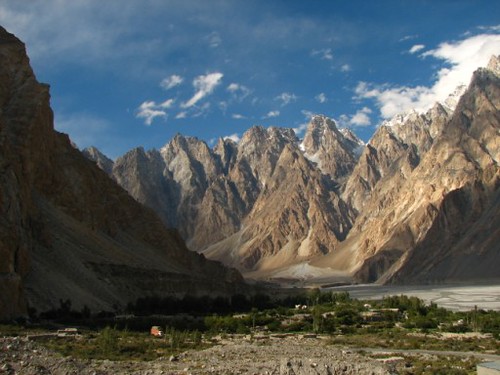 Mountain spires and rugged grandeur at Passu
Mountain spires and rugged grandeur at Passu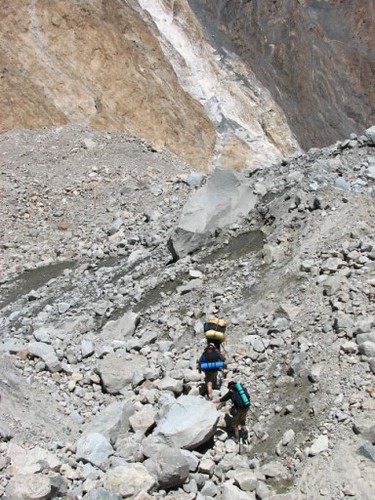 Crossing the glacial choss pile on the first day of Batura trek
Crossing the glacial choss pile on the first day of Batura trekThe Batura glacier itself is one of the longer glaciers (~58 km) in the Karakoram. It was an ideal aclimatisation trek with a gentle ascent and a few days at higher altitudes. Crossing the glacier was the first challenge and to be honest we would have been totally stuffed without Habib. It was a massive pile of unconsolidated choss and i have no idea at all how he managed to find the 'path' through the rubble, ice and debris. It was a relief to get off such loose ground and once on the other side we followed along the ablation valley and lateral morraine for much of the rest of the trek. Anna an i spent a little time on the first day collecting aromatic mountain herbs, a type of sage and lavender, to use as an inscence offering during the wedding ceremony. Sooo romantic!!
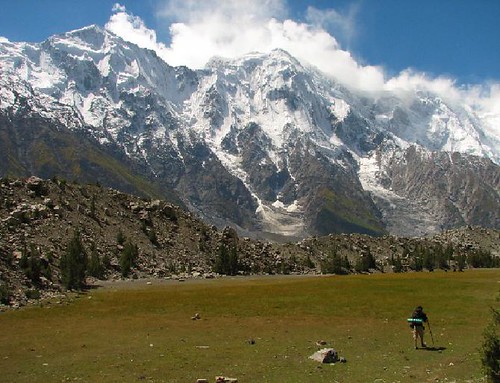 Joe walking in the ablation valley with the Batura wall in the background
Joe walking in the ablation valley with the Batura wall in the background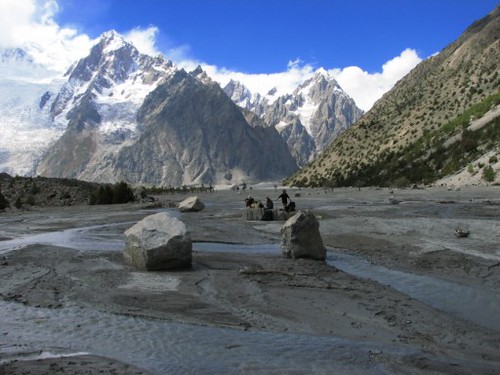 One of many rest stops along the Batura ablation valley
One of many rest stops along the Batura ablation valley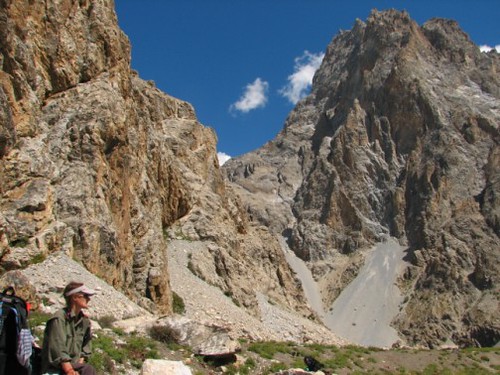 Rest stop with a view
Rest stop with a view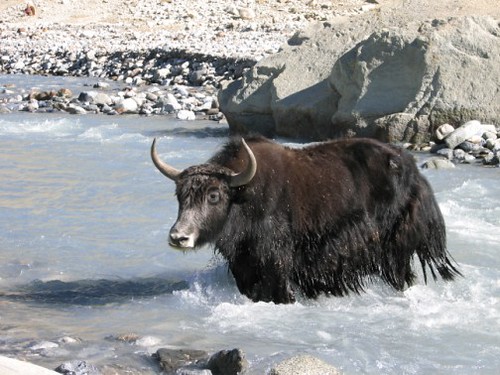 A Batura Yak taking an early morning glacial dip
A Batura Yak taking an early morning glacial dipThe Batura wall opposite us was a long, ice-capped ridgeline >7000m, rising to a full height of 7800m at its multiple peaks. Gradually more and more of it was revealed as we continued up the valley. It is very imposing with outrageously steep gullies, gargantuan cornices and no easy or obvious lines of ascent. The regular thump and roar of avalanches crashing down its slopes stopped us in our tracks in awe. The deception of scale becomes apparent when you realise that the avalanches are travelling at over 100m per second yet they appear to be slowly rolling down the icy slopes.
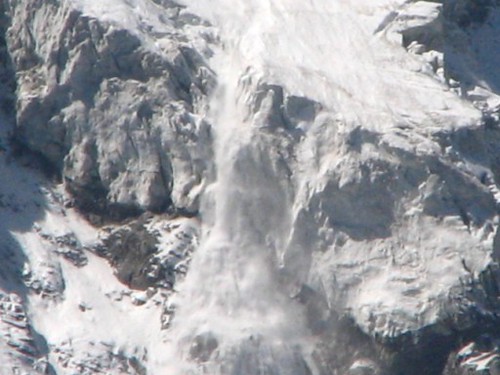 The remnants of an avalanche on the Batura wall
The remnants of an avalanche on the Batura wallIn the 1950's 6 European climbers tried an acsent of the Batura wall from this side. Five were lost and their bodies have never been found. No one has tried from this side again since. Looking at it, i understand why. In the full moonlight and outstanding weather that we experienced on the first few days, it is a truly awesome sight - but it is not for people - it is for crashing ice and elemental forces of wind and rock.
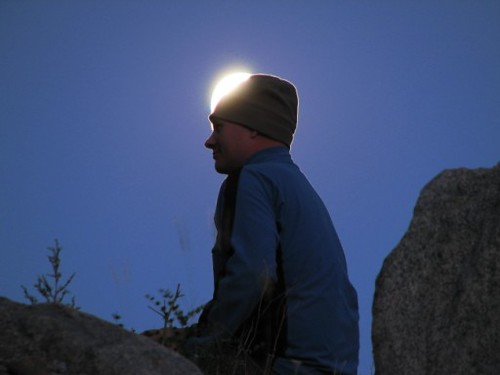 Third eye cranking! - Mark lit up by the rising full moon on the Batura trek
Third eye cranking! - Mark lit up by the rising full moon on the Batura trekWe were blessed by brilliant weather for the entire trek - sunny blue-sky days and luminious, moonfilled nights. One of the amusing things we had to contend with during the journey was speed-raids by rouge sheep and the odd cow on any exposed camp tucker. They have so little to eat up there - other than sparse alpine pasture and gravel - that the smells emanating from our camps were more than enough to overcome any shyness they may have felt at seeing four, strange, white-skined two-legs in their territory. Hungry sheepies can be persistant!
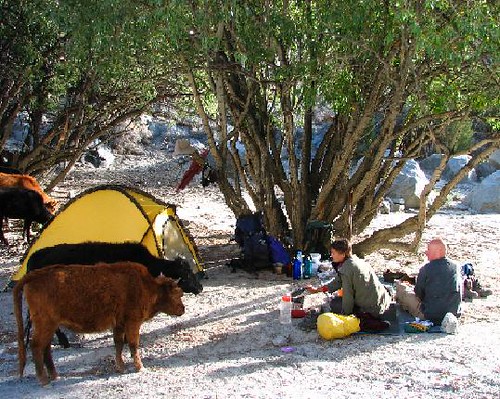 Camp 1 being besieged by salivating bovines
Camp 1 being besieged by salivating bovines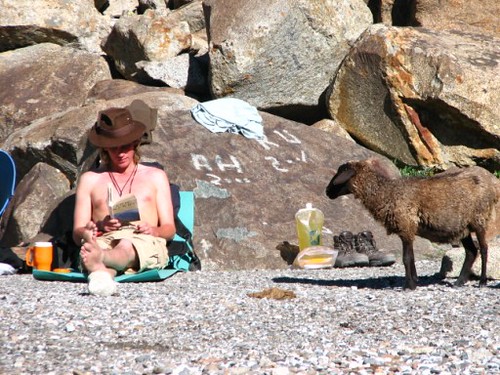 "Co'mon mate, give us some"; A hungry and persistant sheepie checking Joe out for some tucker
"Co'mon mate, give us some"; A hungry and persistant sheepie checking Joe out for some tuckerThe trek had the usual share of culinary disasters and successes. Its funny, when you are using so much physical energy and have a limited and daily-rationed amount of food, tucker takes on a highly elevated importance. I think the hands down fav. of the trip had to be chapatis cooked in olive oil with vegemite (!!) - an epic production on a kero cooker without a chapati gridle!
The funniest food episode was, of course, the one to which we had the most attachment and expectation! We had some custard powder and had lovingly carried enough drinking chocolate powder to make a batch of chocy custard. At camp 3, high up in the valley, we decided the time for custard had come. Nearby were some huts of seasonal herders grazing their flocks of hungry sheepies and goats. In an effort to promote local produce, sustainable grazing and to inject a little money into the local economy, Joe purchased a couple of litres of fresh goats milk from the herders on behalf of us for use in the custard. How wonderful! We sat, solemly, intensely, four of us perched around the little cooker, in deep meditative anticipation as the luscious, creamy looking milk came to the boil, custard powder was added and the whole mixture made lovingly smooth, thick and chocolatey - too good!! At the first spoonful we all realised the devastating magnitude of our mistake ie. goats milk makes great feta cheese; chocolate is also great; but chocolate-liquid-feta cheese - essentially what our custard had turned into - is just a bad combination! I managed 1/2 a spoon, Anna less, Mark was equally revolted, but Joe had a good crack at a bowl full (very impressive!) - the rest was delivered to some nearby local porters, who being accustomed to goats milk, managed to devour it with ease and returned the empty pot!
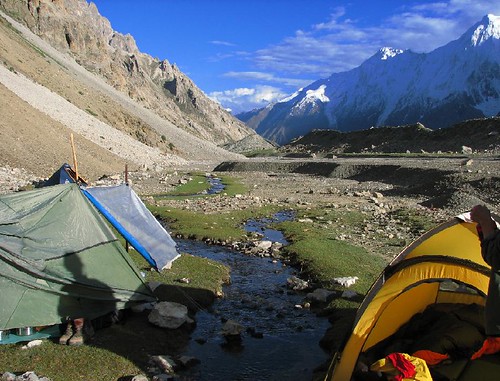 Camp 3 on the Batura trek
Camp 3 on the Batura trek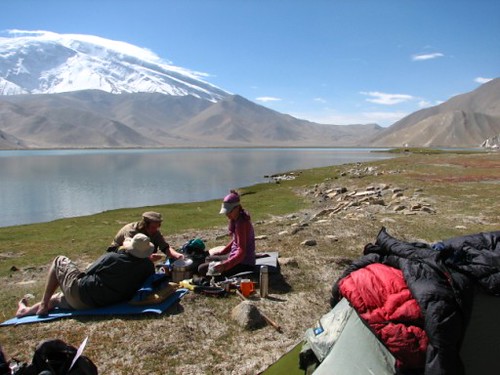 Preping some tucker at Kara Kul - the importance of food inflates substantially when you are trekking
Preping some tucker at Kara Kul - the importance of food inflates substantially when you are trekking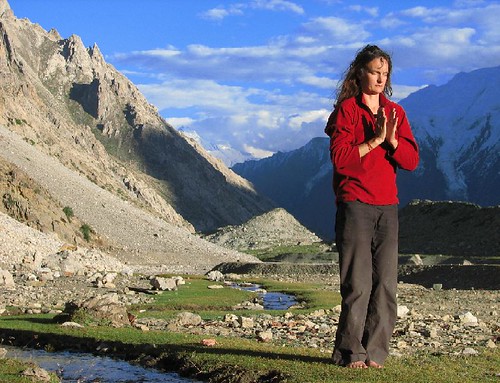 Anna relaxing into Tai Chi in the afternoon light at camp 3 on the Batura trek
Anna relaxing into Tai Chi in the afternoon light at camp 3 on the Batura trek
The high camp of the Batura trek was situated above the main glacier, at ~3900 m, in a steep ravine which contained a small, green, crystal clear lake bounded by high cliffs. A stunning location. Joe definitely took the bravery award by doing a full swim, albiet rather brief, in the freezing lake, even though there was a massive sheet of melting seasonal ice 50m upstream. Even more impressive then eating choclate-feta custard!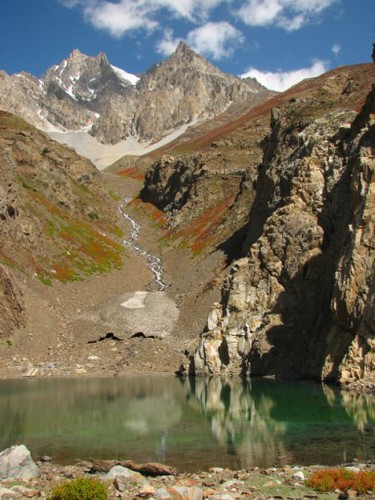 High camp lake on Batura trek, the site of Joes very brave, very short swim!
High camp lake on Batura trek, the site of Joes very brave, very short swim!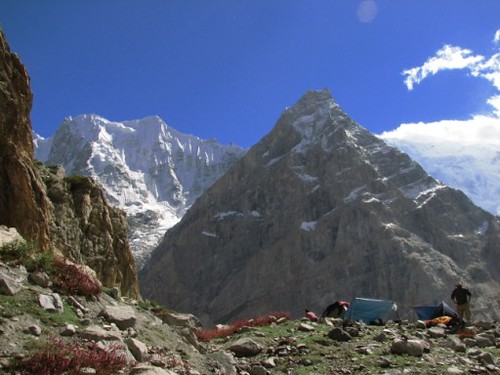 Amazing views from the high camp on the Batura trek
Amazing views from the high camp on the Batura trek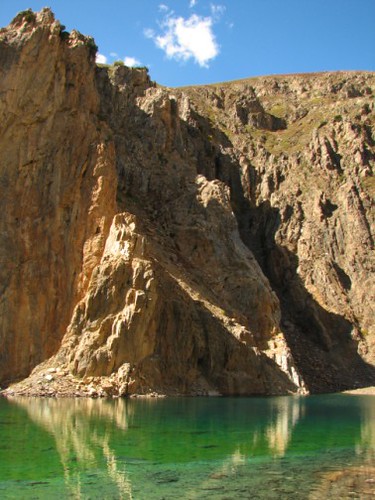 High camp ravine and icy green lake on the Batura trek
High camp ravine and icy green lake on the Batura trek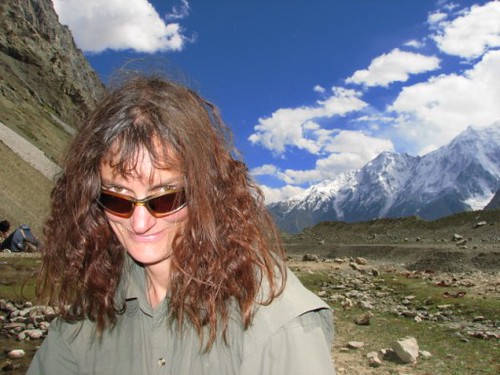 A rather feral Anna looking like she is up for trouble!
A rather feral Anna looking like she is up for trouble!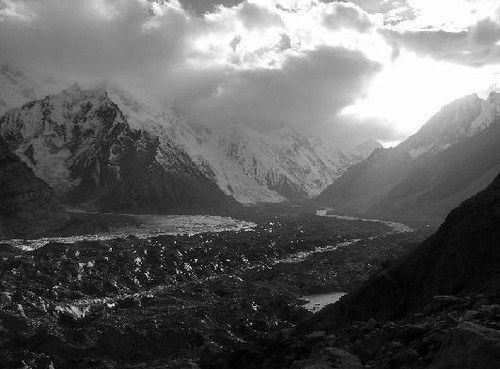 Afternoon light glistening on the upper Batura Glacier
Afternoon light glistening on the upper Batura Glacier
We arrived back in Passu, happy and exhausted. Trekking can be tough at times, both physically and mentally, but the adversity is always rewarded by a clearer and cleaner appreciation of the many simple things that are easy to take for granted; a soft matteress; water from a tap; a light; rest. After cleaning, washing and of course eating our fill of fresh Hunza apples, we got rolling the following day to Sost. From there we easily found a dualcab to take us the final leg of Pakistan, over the Kunjerab pass and into western China.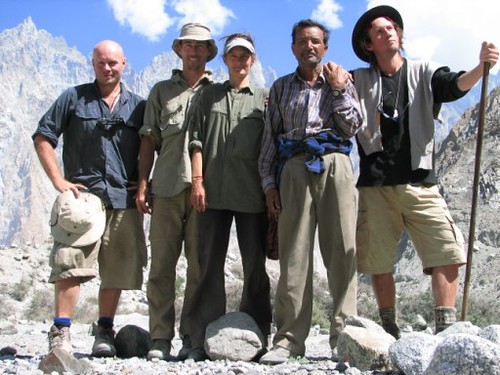 Tired, happy trekkers at the end of 7 days on the Batura
Tired, happy trekkers at the end of 7 days on the Batura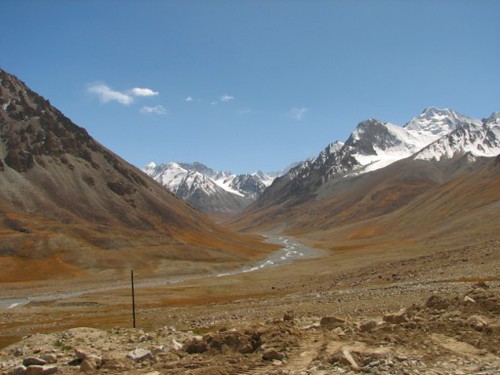 View from Kunjerab Pass on the border of China and Pakistan
View from Kunjerab Pass on the border of China and Pakistan
When we arrived at the border at the top of the Kunjerab pass, the now Chinese road became a brilliant, smooth HWY without potholes - a marked contrast to the Pakistani side. The fresh faces of confident Chinese soldiers at the border post said volumes to me about a country that is clearly on the up and knows it.
The wide, dry plains alongside the border of Tajikistan finally gave way to Tashkurgan, where we contronted Chinese customs games, who seemed particularly interested in our walking sticks, diligently shaking them and checking for false bottoms. Tashkurgan had bizzare wide streets, but no traffic; flash and tiled two storey facades fronting the streets, but with collapsing mud brick slums hidden behind. It was here we had our first encounter with a Super market, Chinese style, in weeks.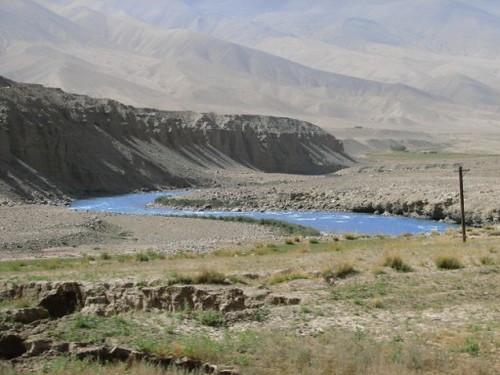 Sky blue river on edge of Tajikistan
Sky blue river on edge of Tajikistan Tashkurgan: Our first Spuer Markep in weeks,...
Tashkurgan: Our first Spuer Markep in weeks,...
Travelling as a group has been a blessing, in many ways really. We allow each other space, but regularly check-in and having four people to share organisation tasks is much, much easier. We are getting to see all sides of each other, the rough and the refined, and the sense of support and immersion in a shared experience is strong. I can only write from my experience, but i am happy with the level of harmony we have established and am sure Mark, Joe and Anna feel the same way. Some light moments, some intense moments, and all moments in between, but we are managing to support eachother through it.
We left Tashkurgan the following day, keen to get back to altitude by camping at Kara Kul Lake, a side-stop on the way to Kashgar. After a quiet altercation with a bus driver determined to part us from more money than he was entitled (to which Mark very patiently and successfully resisted), we alighted from a bus the following morning at the stunningly turquoise Kara-kul lake.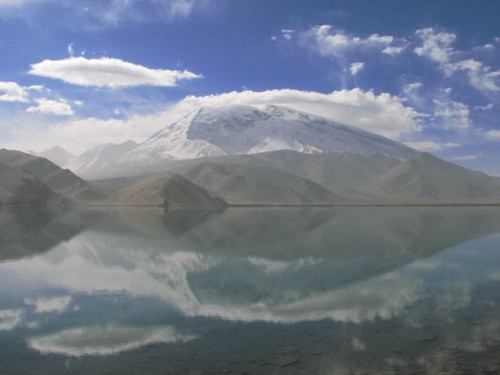 Magnificent Muztagh Ata reflected in the waters of Kara Kul Lake
Magnificent Muztagh Ata reflected in the waters of Kara Kul Lake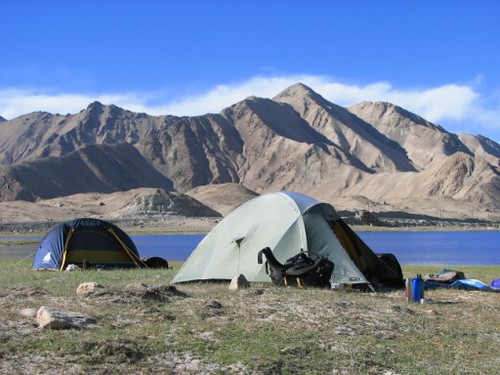 Camp site at Kara Kul Lake
Camp site at Kara Kul Lake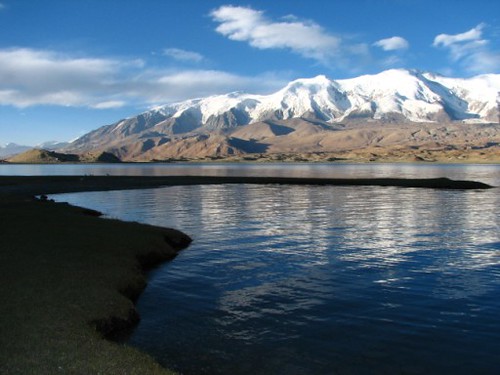 Reflections in Kara Kul
Reflections in Kara Kul
At 3700 m, it afforded good acclimatisation. Tucked away at the edge of Tajikastan in the Pamirs, at the base of Mustagh Ata, a 7500 m peak whose name means 'Father of Ice Mountains', the setting was absolutely stunning, and devastatingly windy! We spent a couple of days there, reading, walking, hiding from the wind in our tents and meandering before flagging down a Kashgar bound bus for the final leg of this part of the journey.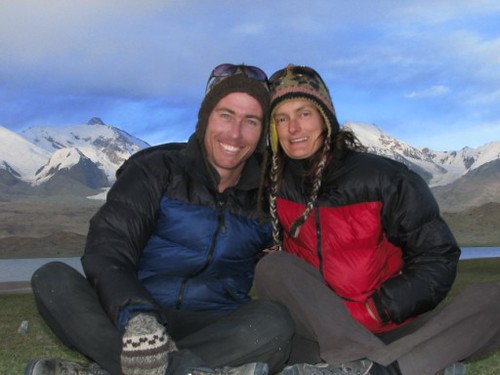 Anna and Scott rugged up and hugged up
Anna and Scott rugged up and hugged up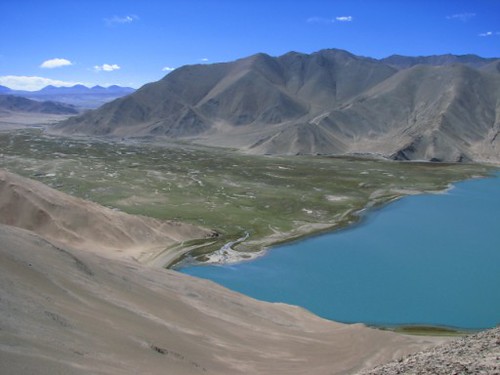 Kara Kul Lake valley infill and Yak pastures
Kara Kul Lake valley infill and Yak pastures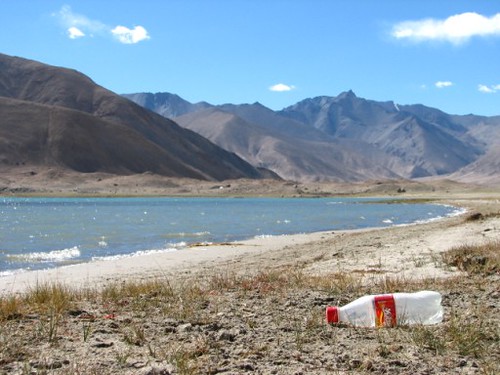 Beauty and the beast - they really are a multi-national aren't they,.....
Beauty and the beast - they really are a multi-national aren't they,.....
So, here at Kashgar today, gone tomorrow. Back into the flux and whirl of journeying and pilgrimage. Western Tibet is the next stage and there is a sense that transport, permits and all things become a bit more uncertain and fluid from here on in. A long journey across the Aski Chin Range awaits us and hopefully we have all spent enough time at altitude to handle the >5000m passes without undue drama. There is a satellite view of Mt Kailash and Lake Mansarovar below. Intentions set, karma unfolding,......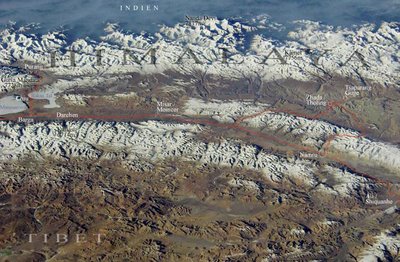
So, there will be no more blog updates until late October / early November, when we get to Lhasa - all karmas being considered of course! So, with much love and warmth from all of us - to you family and friends who fill our lives with much meaning and joy - Ciao for now. Much peace.
Scott.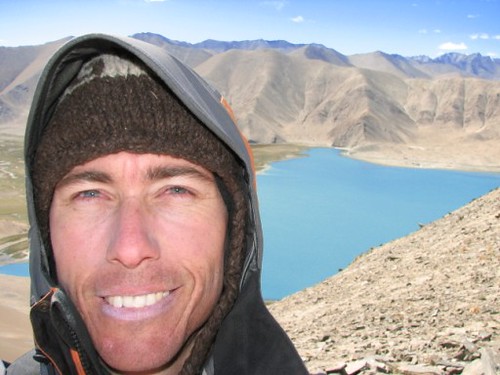 Scott trying not to blow away on the summit of small peak near Kara Kul lake
Scott trying not to blow away on the summit of small peak near Kara Kul lake



